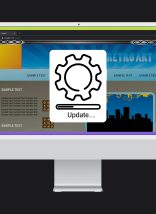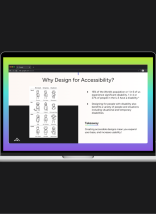There are many different pieces to obtaining digital accessibility, and it can be an issue that needs clarification. Atlantic BT can help you feel confident that your site is in compliance with the latest accessibility regulations to reach a larger, more inclusive audience for your company.
But let’s take a step back and think about why it matters. Digital spaces are essential to the way we live our lives. “We” is a collective, inclusive word. So digital solutions wind up affecting the lives of every person who has access to the Internet. It is clear that designing web experiences for all users, regardless of ability or potential needs, is a crucial component of modern web design. Not to mention, it is also the law. Web accessibility is an element of your website that can not be ignored.
Why Should You Care About Website Accessibility?
Americans With Disabilities Act
While the ADA does not explicitly mention websites in its language, it does prohibit discrimination based on disability in places of public accommodation. As many organizations have discovered, the ADA has been applied to lawsuits over inaccessible websites. Perhaps one of the most famous was the National Federation of the Blind’s lawsuit against Target in the mid-2000’s, which led to Target settling the case for $6 million.
Section 508
Section 508 of the Rehabilitation Act, is another law that many of our clients have their eyes on. Organizations that are subject to Section 508 have a clear requirement to meet accessibility standards. As of January 2018, these organizations are now required to make sure their websites meet the guidelines laid out in Level A and Level AA of the Web Content Accessibility Guidelines 2.0 (WCAG 2.0).
Appeal to a Wider Audience
Aside from the law, there are benefits to making your website more inclusive.
- Provides key services to people with disabilities
- Increases the audience or customer base an organization can reach through its website
- Often makes sites easier for all users
And the need for accessibility continues to grow. According to the CDC, more than 20% of adults in the United States have a disability. That number is only likely to go up as the population ages.
How We Create Accessible Websites
Making accessible websites requires careful planning for success. Of course, not all of our clients have the same accessibility needs, so each is handled on a case by case basis. A typical project looks something like this:
Make an Accessibility Plan
During our discovery phase, we identify what accessibility requirements a client has. We will additionally scan for issues that we will need to mitigate later on. For example, a lot of old sites have videos and PDFs that no longer meet accessibility guidelines. Whatever the specifics may be, sticking to the initial audit ensures we know what goals we need to meet.
Technology’s value lies in what it allows people to do. By designing inclusively and making digital products accessible to all users, we make our technology more valuable. We bring this perspective to every project which makes our products that much stronger.
– Gordon Chadwick, User Researcher, CPACC
Design a Site Everyone Can Use
With requirements in hand, our designers apply styles that both function and delight. We’re long past the days when people thought designing an accessible website meant designing an ugly website.
Accessibility isn’t just about blind users and screen readers, it is about everyone. Designing for all people encourages exploration of new ideas and solutions that lead to a better product overall.
– Maris Hall, User Experience Designer, CPACC
Develop Using Best Practices
Building accessible sites doesn’t mean bolting on tons of features, it means following best practices for front end development. Clean, well-structured code is the foundation that allows screen readers and other assistive technology to function.
When you start paying attention to the needs of all of your users, you begin to see how wonderfully diverse your audience is and you start looking for ways to give everyone a seat at the table. Since I’m usually working on implementation, I make sure the sites I build provide a good experience for users of assistive technologies like screen readers or magnifiers.
– Mark Andrews, JavaScript Developer
Test and Verify
Testing is how we ensure that the work we did meets the goals we set during the planning stage of a project. Since meeting success criteria is of critical importance, our testers have several different ways to verify that we hit the mark. Testing methods include:
- Automated Testing – We use automated checkers to identify accessibility issues in your code.
- Expert Reviews – Certified accessibility professionals review behavior on your site.
- User Testing – Go straight to the source and test with users who have disabilities.
There is a wealth of information on the web and everyone should have equal access to it. I make sure that we’re making that a reality by accounting for accessibility as we build things instead of after they get released.
– Yolanda Hyman, Quality Assurance Manager
Start Feeling Good About Accessibility
It’s easy to understand why accessibility is important. However, uncovering potential issues and implementing changes can be a complicated process. Atlantic BT is happy to guide you through requirements and implement the necessary changes to make your website not only compliant, but accessible and inviting to all users. Reach out today for a free consultation or to get in touch with one of our accessibility experts.






